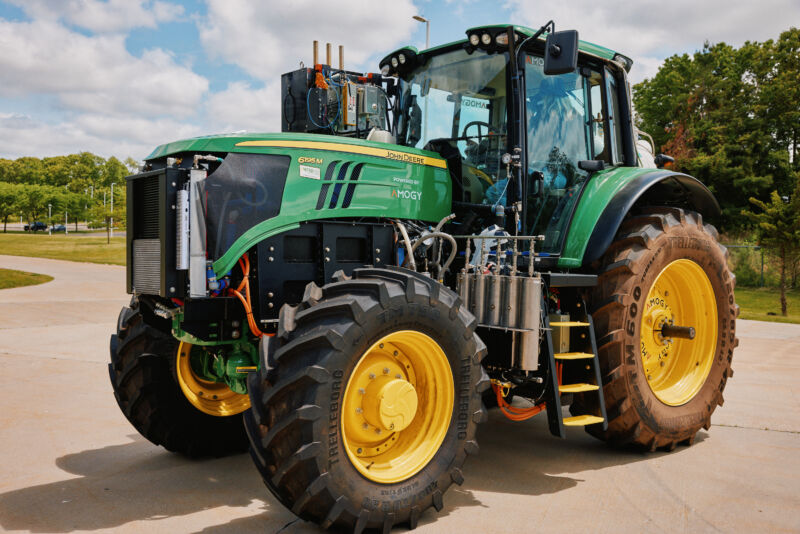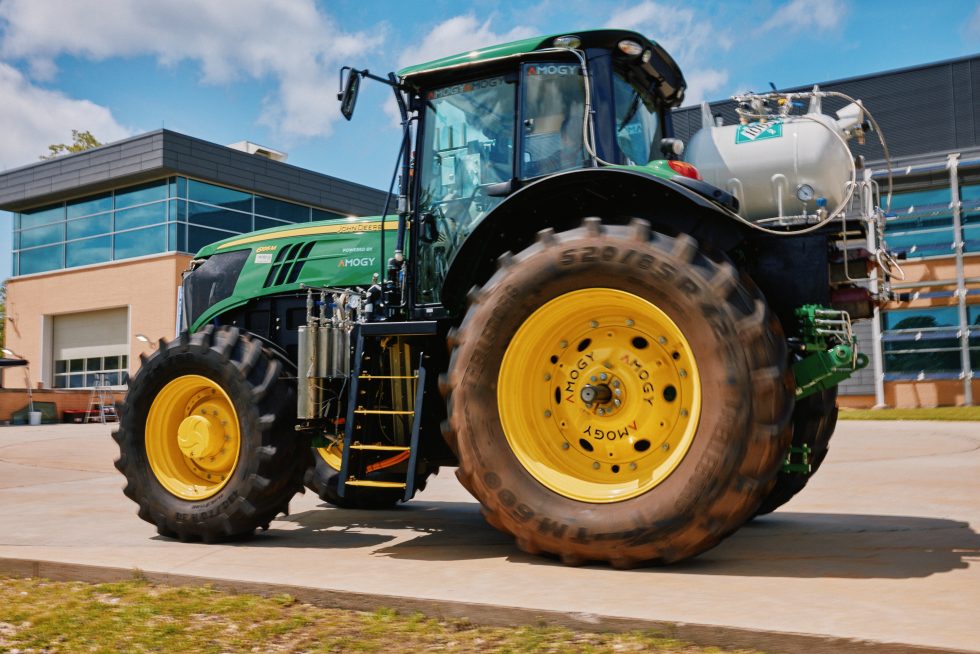

World’s first ammonia-powered zero-emissions tractor starts testing
source link: https://arstechnica.com/cars/2022/06/worlds-first-ammonia-powered-zero-emissions-tractor-starts-testing/
Go to the source link to view the article. You can view the picture content, updated content and better typesetting reading experience. If the link is broken, please click the button below to view the snapshot at that time.
World’s first ammonia-powered zero-emissions tractor starts testing
Ammonia is already a widely used fertilizer, so the infrastructure is in place.
Jonathan M. Gitlin - 6/1/2022, 12:00 PM

The world's first ammonia-powered zero-emissions tractor successfully completed its first demonstration run at the Advanced Energy Center at Stony Brook University in New York last week. The midsized John Deere tractor had its diesel engine replaced with an "ammonia to power" system developed by a startup called Amogy. The system converts the energy-dense chemical into hydrogen, which then powers a 100 kW hydrogen fuel cell.
Although most EV coverage is devoted to consumer-oriented passenger cars and light trucks, medium- and heavy-duty vehicles represent more than a quarter of US vehicle emissions and are important targets for decarbonization. The low-energy density of batteries and their long charging times make fuel cells an attractive zero-emissions solution, and we've looked at the potential uses for hydrogen fuel cells in trains, trucking, and mining in the past.
But even the greenest hydrogen still isn't very energy-dense, and outside of California, there's little hydrogen infrastructure to rely upon.
Anhydrous ammonia, on the other hand, is widely used in farming as a fertilizer. It's not the most pleasant chemical in the world to work with, but given its energy density, people have looked at it as a potential fuel for farm equipment. In the past that has meant combustion engines that burn a mix of ammonia and diesel, which emits less carbon dioxide than a purely diesel-powered tractor, but still emits some of the pollutant.
AdvertisementAmogy's system can power the tractor for several hours on a 60-gallon tank of ammonia. But it's not used directly in the fuel cell; instead, the ammonia is cracked in a reactor to make hydrogen on-demand, which is then used to power the fuel cell. While there are inefficiencies in the system, Amogy says that the higher energy density of ammonia in the first place means you can easily carry enough fuel to compensate, coming out ahead of a normal hydrogen fuel cell in terms of both energy and power density.
Don't expect to see ammonia-powered fuel cell tractors working the farm just yet, though. After this demonstration of a medium-duty vehicle, Amogy plans to scale up, including demonstrating a 1 MW system later in 2022.
"As we continue our work to lead innovations in ammonia-based fuel solutions, the Amogy team believes this demonstration and future ones, including Class 8 trucks and shipping vessels to be demonstrated in the next 12 months, will accelerate the adoption of ammonia as the next generation fuel to replace polluting diesel engines with an emission-free solution among transportation industry sectors and investment partners," said Seonghoon Woo, Amogy's CEO.
Promoted Comments
-
That tractor would carry about 86 gallons of diesel in a tank that wraps around the bottom of the transmission. Obviously this is just a prototype but finding space for a pressure vessel tank on a tractor could be challenging. The current position of the tank on the prototype would definitely interfere with 3-point attachments but I'm sure they know that. I may have missed how they are actually making power but the 100 KW < the factory 196 HP this tractor would have. If it's being delivered thru an electric motor then maybe it's comparable. Based on (https://www.tractordata.com/farm-tracto ... tests.html) it looks like the tractor would carry about 9-10 hours of fuel if operated at full power. I'd be interested to know if their "several hours" was at full power or at some reduced power level.
The factory specs for this machine can be found here https://www.deere.ca/en/tractors/row-cr ... m-tractor/
Anhydrous ammonia is also a NASTY substance to work with. I've dealt with it on the farm as well as in food processing (refrigeration). On the farm I accidentally opened the valve while setting up a variable rate application system and almost took out the tech working in the back.. At the factory I just remember the power engineers telling me that if I saw the warning light start flashing in the engine room (where the ammonia refrigeration compressors were) to hold my breath and run... It's an interesting idea but there seem to be definite potential issues.
Recommend
About Joyk
Aggregate valuable and interesting links.
Joyk means Joy of geeK
